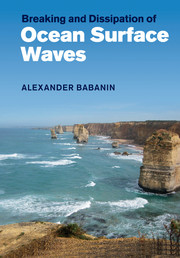Measurements and even detection of wave breaking are challenging tasks, particularly if carried out by unattended devices in the open ocean. As a result, there are vast amounts of wave records accumulated, and most of them contain breaking waves, but information about the breaking cannot be extracted. There is an obvious need for methods and instrumentation to directly detect breaking events and measure their properties, and for the analytical means and criteria to identify the breaking waves in existing time series of surface elevations.
Until recently, visual observations were arguably the only reliable means of breaking detection. These are based on viewing and quantifying information on whitecaps produced by breaking waves and are obviously biased towards large breakers (see Section 2.8). Over the past two decades, more technological methods have become available, both contact type and by remote sensing of the ocean surface or subsurface. These utilise acoustic (passive and active), optical (both visible and infrared range), reflective and other properties of breakers which distinguish them from the more homogeneous background wave field.
Without giving a comprehensive review, we will mention here passive acoustic techniques based on air bubbles ringing while being created during air entrainment (e.g. Lowen & Melville, 1991a; Ding & Farmer, 1994; Babanin et al., 2001; Manasseh et al., 2006), sonar observations of bubble clouds produced by breaking wind-waves (e.g. Thorpe, 1992), aerial imaging (e.g. Melville & Matusov, 2002; Kleiss & Melville, 2011, 2010), infrared remote sensing of breaking waves (e.g. Jessup et al., 1997a), radar observations of microwave backscatter from breakers (e.g. Jessup et al., 1990; Lowen & Melville, 1991a; Smith et al., 1996; Phillips et al., 2001), and conductivity measurements of the void fraction produced by breakers (e.g. Lammarre & Melville, 1992; Gemmrich & Farmer, 1999),amongst others.
